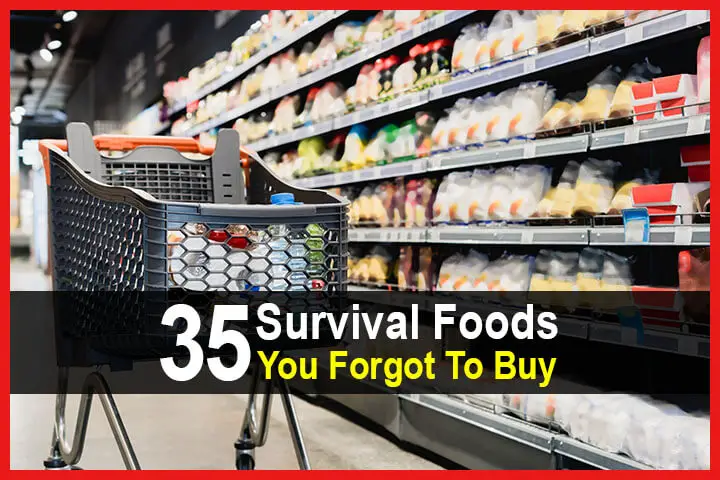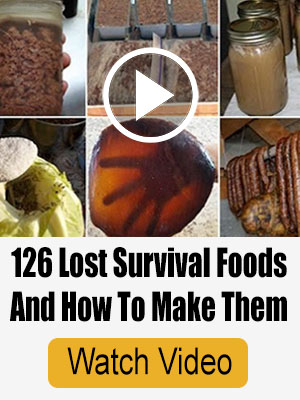Estimated reading time: 10 minutes
When it comes to survival foods, there are the staples such as rice and beans and pasta that can be found in almost every bunker. But there’s a whole host of other great survival foods that are often overlooked.
If you’re a prepper, then chances are you already have most of the foods on this list, but I’m posting it on the off chance that you’ll come across a few great survival foods that you simply forgot. For example, I was recently surprised to discover I didn’t have any taco seasoning stockpiled, which is crazy because I love tacos!
I thought sure I had some, but apparently I used it all and forgot to replace it. You can bet I fixed that situation immediately.
Want to save this post for later? Click Here to Pin It On Pinterest!
Below you’ll find a list of 35 survival foods you might have forgotten to buy:
1. Almond Butter
While peanut butter is common, almond butter is often overlooked. It’s a great source of protein and healthy fats, and its shelf life is impressive. It’s perfect for a quick energy boost or as a tasty spread on crackers.
2. Apple Cider Vinegar
With its indefinite shelf life, apple cider vinegar is not just for salad dressings. It’s a multipurpose item useful for preservation, cleaning, and even as a health tonic. Its tangy taste can also add a nice zing to your post-disaster cooking.
3. Baking Soda
While known for its role in baking, baking soda’s long shelf life makes it a must-have for more than just making cookies. It’s a versatile agent for cleaning, deodorizing, and even toothpaste in a pinch.
4. Bouillon Cubes
Bouillon cubes have an indefinite shelf life and are a great way to add either a chicken or beef flavor to the meals that you prepare. If you’re throwing together a stew with whatever you have on hand, I can tell you from personal experience that bouillon cubes make a huge difference. Don’t forget about them.
5. Canned Tuna
Enjoying meat long after a disaster means either hunting/fishing for it yourself or eating it out of a can. Canned tuna is a great place to start if you opt for the latter option, as it is affordable and has a decent shelf life. Be sure to get the kind that comes in oil, not water, as it has more calories.
6. Canning and Pickling Salt
Most everyone remembers to add iodized salt to their stockpile, but did you know that you can’t use regular iodized salt for canning and pickling? Instead, you will want to ensure that you have canning and pickling salt at your disposal.
7. Cocoa Powder
Cocoa powder can last 30 or more years if stored properly, allowing you to enjoy a nice, warm cup of hot chocolate at any point after the SHTF. It’s especially great to have in winter months or if you have children.
8. Coconut Oil
As a general rule, oils don’t last very long. Coconut oil is the exception, though, with a shelf life of 2+ years. As an added bonus, coconut oil is one of the healthiest oils that you can cook with. As any paleo dieter will tell you, it’s far healthier than vegetable oil. Plus, it has many survival uses.
9. Dried Herbs and Spices
Beyond the basic salt and pepper, stocking a variety of dried herbs and spices can transform your post-disaster cooking. They have a long shelf life and can bring life to the most basic ingredients.
10. Dried Lentils
Often overshadowed by beans, dried lentils are a nutritional powerhouse, high in protein and fiber. With a shelf life of 30+ years, they cook faster than most beans and are incredibly versatile in soups, stews, and even salads.
11. Dried Seaweed
With its long shelf life, dried seaweed is a forgotten treasure. It’s not just for sushi – it can be a source of essential minerals and vitamins and adds a unique flavor to broths and soups.
12. Garbanzo Beans
Garbanzo beans – also known as chickpeas – are high in protein, flavorful, affordable, and when purchased dry, they have a shelf life of 30+ years. While dry pinto beans are a staple among preppers, garbanzo beans are often overlooked. Given their flavor and nutritious value though, this shouldn’t be the case.
13. Hard Cheese in Wax
Hard cheeses encased in wax can last for years and are often forgotten in favor of more perishable dairy products. They provide a great way to add a gourmet touch to post-disaster meals.
14. Honey
Honey has an indefinite shelf life, and when I say indefinite, I mean it. Archaeologists found pots of honey in a 3000-year-old tomb and it was still edible! Honey is a great way to sweeten up your meals and drinks post-disaster, and it’s very good for you. I eat a tablespoon anytime I start coughing and it seems to work better than Robitussin.
15. Instant Coffee
Easy to make and energizing, instant coffee has a shelf life of 30+ years, allowing you to continue enjoying a steaming cup of Joe in the morning come what may. If you hate the taste, here are a few other ways to make coffee.
16. Jello
Jello powder has an indefinite shelf life. While Jello certainly isn’t the healthiest survival food, stocking up on powdered Jello packets will allow you to enjoy the occasional sweet treat when times get tough. This is another great one to stock up on if you have children.
17. Kamut
Kamut is a type of wheat and, like millet, is another alternative grain for you to consider stocking up on. It’s very nutritious, easy to digest, and packed with more energy than regular wheat.
18. Kool-Aid
Kool-Aid is another powdered water enhancer that lasts for years. Though it’s not nearly as nutritious as Tang, you may find the flavor to be a little more appealing, at least for special occasions.
19. Maple Syrup
Maple syrup has an indefinite shelf life, meaning that if you are able to figure out a way to make pancakes after SHTF then you will have the perfect topping for them. Personally, I can’t imagine eating pancakes without it.
20. Millet
You may know millet as the main ingredient in birdseed, but millet has also been a staple of mankind’s diet for thousands of years. This affordable, nutritious grain presents a good alternative to wheat and rice. It’s also a great option for people with a gluten sensitivity.
21. Pancake Mix
Speaking of ways to make pancakes post-disaster, pancake mix is affordable and easy to store. It only has a shelf life of about a year, though, meaning that you’ll have to replace your supply every year, which may be more trouble than it is worth.
22. Popcorn
My wife would be furious if we ever ran out of popcorn, so we have quite a bit of it on hand. Note that we’re not talking about the microwavable popcorn. Instead, stock up on the kind of popcorn kernels that you have to pop on the stove or over an open flame. They last forever and make for a tasty snack.
23. Powdered Eggs
Same story, different food. To keep enjoying eggs after a disaster, you may have to make the switch to the powdered variety. Granted, most powdered eggs don’t taste very good, so you might want to try getting used to them before they become the only option. They’re worth it, though, for all the nutritional benefits.
24. Powdered Milk
We all know ordinary milk doesn’t last long. To enjoy milk after a disaster (or at least some version of it) you will want to either secure a milk cow or stock up on dried milk, which has a shelf life of 20+ years when stored properly. For most people, the latter option is going to be far more convenient.
25. Protein Bars
These aren’t just for bodybuilders. Protein bars are great for preppers, as well, providing a quick boost of a nutrition that is often in short supply during disaster scenarios. They’re also one of many great foods for your bug out bag. Just be warned that the kind with chocolate are liable to melt.
26. Pudding Mixes
Pudding mixes are like Jello in every way from a survival standpoint (tasty, long-lasting, unhealthy) but in a different flavor. If you like it, you’ll be glad you have it.
27. Quinoa
This ancient grain is a complete protein and lasts for years. It’s a fantastic rice alternative and can be used in a variety of dishes, from breakfast porridges to hearty dinners.
28. Raisins
Just a cup full of raisins is equal to a full serving of fresh fruit in terms of nutrients. These dried grapes are full of protein, fiber, iron, potassium, Vitamin C, and antioxidants. Raisins can be used as an addition to other dishes or eaten by themselves for a healthy snack. For even more variety, consider stocking up on a number of dried fruits such as dried bananas, strawberries, plums, and more.
29. Ramen Noodles
Ramen noodles aren’t the best food to sustain yourself with as they’re very high in sodium and generally pretty unhealthy. But if money is tight, they’re a good option as they’re dirt cheap, tasty, and last forever. If thousands of college students can survive on them, so can you.
30. Soy Sauce
Often forgotten, soy sauce can last for years and is a fantastic way to add flavor to meals. Its salty, umami character enhances rice, stews, and even makeshift stir-fries.
31. Taco Seasoning
Turn ordinary ground beef into a tasty meal with a packet of taco seasoning. These pre-mixed spices last forever and can add a Tex-Mex kick to any ground meat (beef or not). I personally use it with canned chicken to make chicken tacos or chicken taco salad.
32. Tang
Tang allows you to turn ordinary water into orange juice (sort of), and it was even used by NASA when they flew astronauts to the moon. Regardless of whether or not you find Tang to be a good substitute for orange juice taste-wise, it is full of great nutrients such as Calcium and Vitamin C.
33. Textured Vegetable Protein (TVP)
An excellent meat substitute, TVP is high in protein, has a long shelf life, and is incredibly versatile. It’s perfect for vegetarian dishes or extending meat in recipes.
34. Vanilla Extract
If you want to add a little sweet vanilla flavoring to the dishes you prepare post-disaster, we’ve got some good news: Pure vanilla extract has an indefinite shelf life, allowing you to sweeten your foods and drinks long after the grocery stores have closed down. I always have some on hand because I use it when I make pancakes.
35. Yeast
Bread won’t last long post-disaster, but the ability to make bread will enable you to keep it on the table long after every loaf in the supermarket is gone. But to make bread, yeast is one of the things you will need to have on hand.
Like I said, the majority of preppers probably already have most of the foods on this list–and I’m sure I’ll get a few comments to that effect–but my hope is that you at least saw one or two foods you either forgot to buy or hadn’t yet considered.
Food fatigue is very real, so when the SHTF, you’ll want a wide variety of things to eat for both your physical and psychological health.
Like this post? Don’t Forget to Pin It On Pinterest!



















